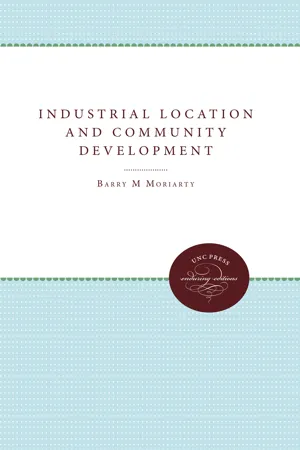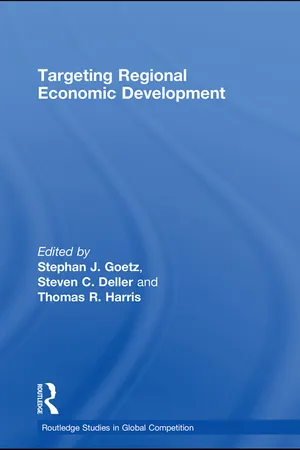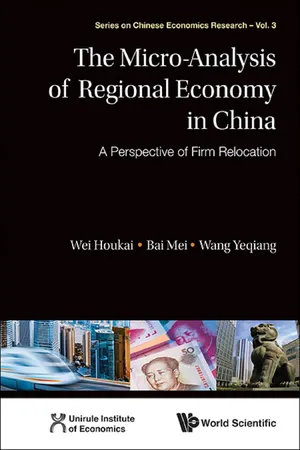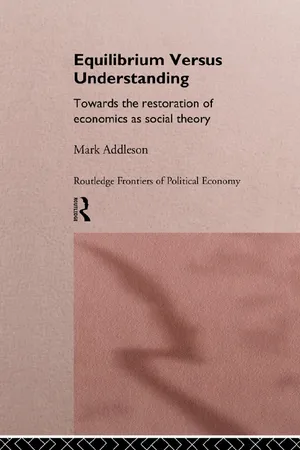Economics
Location of Production
"Location of production" refers to the geographic area where goods or services are manufactured or provided. Factors such as labor costs, transportation expenses, and access to raw materials influence the decision of where to locate production facilities. This decision can impact a company's competitiveness, profitability, and overall efficiency.
Written by Perlego with AI-assistance
Related key terms
8 Key excerpts on "Location of Production"
- eBook - ePub
- William P. Anderson(Author)
- 2012(Publication Date)
- Routledge(Publisher)
Part III Location theoryPassage contains an image
13 Transportation and location
DOI: 10.4324/9780203114988-16This is the first of a series of chapters that deal with the location decisions of firms – a branch of economic geography known as “location theory.” Here we begin a significant departure from the models presented in Part II by shifting our analysis from discrete space to continuous space. This means that, instead of a space comprising a finite set of regions, we consider a space of points, each of which can be defined by a set of (x, y) coordinates. Since, at least in theory, an infinite number of such points exist, analysis in continuous space is more exacting. The advantage is that critical factors such as distance, transportation cost and travel time are “point-to-point” concepts and therefore are more realistically set in continuous space.The spatial configuration of economic activities is the outcome of a great many individual location decisions. One of the most important questions that economic geographers ask is therefore: why does a firm choose to locate at a particular point in space? A variety of factors can influence the firm’s location choice:- Transportation costs. Each firm faces transportation costs associated with getting inputs to its production site and getting its goods and services to its customers. The firm can minimize these transportation costs by choosing the right location. As we will see, that “right” location may depend on a number of factors, including the relative cost of transporting inputs and outputs, the firm’s scale of production and the relative price of inputs.
- Taxes, land and utilities cost.
- eBook - ePub
- Barry M. Moriarty(Author)
- 2018(Publication Date)
- The University of North Carolina Press(Publisher)
Gross localized raw materials (those found at specific locations but that contain large amounts of impurities that must be disposed of) require that plants be located close to the material site in order to avoid transporting waste material. For example, the copper refiner who processes a highly localized ore that is less than 5 percent pure is strongly attracted to a location near the copper deposit. With the passage of time more and more industries have shifted from using basic raw materials as major inputs to using finished component parts. Such components are actually localized pure raw materials, which are more easily transported than the fully assembled final product. Firms manufacturing such products have a great deal of flexibility in the locational decision.Table 5.1. Total Payroll as a Percentage of Value of Shipments, 1972A major factor in the cost structure and profit margin of a manufacturing firm is the geographic location of its markets. Firms in many industries, such as the automobile industry, have close linkages to related industries, which constitute the sole market for their product. The market may actually consist of a single location, making geographic proximity vital. Often extensive interindustry linkages have evolved that are closely related to a complex system of firms that serve as markets for one another’s production. Cities such as Detroit have emerged as centers of specialized production because of the need for geographic proximity among suppliers.If the manufacturer may be supplying consumer products for a set of warehouses, retail outlets, or households, the market is better viewed as an area. At the regional search level, consideration of the geographic extent of this area can be a crucial location factor, a factor that has too often been neglected; consequently, the costs of distributing products have been underestimated. Such miscalculations can result in overlooking some customers who may be within the economical market range of the industrial plant.Historically, manufacturing has been greatly affected by transportation linkages and access. Since the beginning of the Industrial Revolution man’s ability to overcome the friction of distance has continually improved. Initially, bulky products could be moved only by water and so, ports necessarily developed as important break-in-bulk industrial locations. The advent of the railroad greatly influenced the number of potential sites for manufacturing. The combination of rail and water spurred the development of extensive manufacturing complexes along the East Coast and the Great Lakes. However, as the country switched from railroad to interstate highway freight, new manufacturing cities emerged (table 5.2 - eBook - ePub
Chinese Foreign Direct Investment
A Subnational Perspective on Location
- Tao Qu, Milford B. Green(Authors)
- 2018(Publication Date)
- Routledge(Publisher)
As the tactical locational decision of MNEs is the major concern of this book, the LSVs will, from now on, exclusively refer to variables that are of spatial variation and exert some impact on the MNEs’ locational choices within a host country. Following is an elaboration of some of the most important LSVs.Factors of productionEconomic factors such as land (including natural resources), labor, capital, and raw materials constitute a region’s aggregate production function. They combine to determine the maximum production potential of a region given certain technologies. Since MNEs are conduits of capital and technology, the cost of labor, land, and availability of raw materials and resources may be relevant.The importance of labor as a locational factor can be shown with two simple statistics: wages and salaries of workers as a proportion of production cost and the wage difference between countries and spatial variation of labor cost within one country (Dicken and Lloyd, 1990, pp. 156 –161 ). In the US, the proportion of wages and salaries of production workers accounted for one-fourth of the value added for all manufacturing industries in 1982. This percentage increases to 46 per cent if all the wages and salaries of non-production workers are also included. Despite mechanization and automation of production processes, labor cost will probably maintain the overall cost significance as a production factor. This is because mechanization and automation cause the gradual shift of labor force from blue-collar to white collar rather than eliminate labor as a fundamental production element.The cost of labor as a locational factor is well founded in locational theory (Smith, 1981) and macroeconomic theory of foreign direct investment (Kojima, 1982). In classical location theory, labor is treated as a general factor that would divert the least transportation cost location if the saving in labor is enough to offset the additional transportation cost incurred by the change of location. Obviously, the immobility of labor is assumed. Within the macroeconomic analysis of foreign direct investment, the comparative disadvantages of some industries in developed countries due to high labor cost and resource deficiency are considered the main reasons for these industries to shift production abroad. Consequently, labor cost should be one of the most important factors affecting the location of foreign direct investment, especially for labor intensive and export-oriented foreign direct investment. These industries are also industries of standardized technology and production processes. - Gary Cook, Jennifer Johns, Frank McDonald, Jonathan Beaverstock, Naresh Pandit(Authors)
- 2018(Publication Date)
- Routledge(Publisher)
At the regional scale, economic geographers have tried to identify key factors in growth. The most important is agglomeration economies, the result of reduced transactions costs, tacit knowledge or local ‘buzz’, the socio-cultural milieu and the presence of a ‘creative class’. Each of these agglomeration advantages enhances regional economic dynamism and flexibility under the right conditions, but equally they can produce regional decline under the wrong ones. Within this work the most important forms of regional economies are extended industrial districts, learning regions and city-regions (Scott, 2006; Storper, 2013).At the global scale, economic geographers recognize that many economic activities are increasingly spatially decentralized, with different locations around the world playing different roles in the production and assembly of a commodity. Multinational corporations, surrounded by dense networks of sub-contractors and licensees, spread production around the world in a process that Richard Baldwin (2006) dubs “the great unbundling” of production. Those studying this unbundling examine not only the economic and power relations constituting the resulting production networks (global production networks) – some firms exert enormous influence while others are just bit players – but they also trace how the spatial strategies of states, labour unions and multilateral governance organizations each affect the resulting structures (Coe et al., 2004).Worlds of consumptionConsumer markets were traditionally studied in terms of the location of retailers, consumer behaviour and the spatial price gradients. The use of central place theory from the 1950s led to a general theorization of the monopolistic nature of spatial market, which challenged conventional economics. Since the 1990s, geographers studying retailing have turned their attention to the spatial strategies of corporate retailers, including their roles within global production networks. This recent research aligns with how economic geographers characteristically begin with geographies of production, unlike mainstream economists who instead focus on markets and consumption (Coe & Wrigley, 2009).- eBook - ePub
- Stephan J. Goetz, Steven Deller, Tom Harris(Authors)
- 2009(Publication Date)
- Routledge(Publisher)
This research provides insights into how regional prospects have changed during a period of rapid technological innovation. Within the spirit of targeted regional economic development (TRED), we seek to better understand how the dispersion of economic activity may be changing both the scale and scope of regional economic activity. The geographic scale of economic clusters and what it means to be a “cluster” may itself be evolving. Indeed, by better understanding the evolving location choices of economic activities, we can begin to ask questions about the nature and extent of economic linkages and activities across space. One might hypothesize that the very notion of economic activities being tightly clustered geographically may be weakening as economic activities disperse across space to more distant locations offering discrete firm advantages. Our concern is what this may mean for the welfare and prospects of rural places and regions.The remaining sections of this chapter are structured as follows: in the next section, we review the literature on modelling industry location choices. We then specify the empirical model and present a regional classification system. The section following discusses the data and variables used in this study. The empirical estimation and results and conclusions and policy implications are presented in the final two sections.Modelling industry location choices
Modelling industrial location choices is a complex undertaking. Debate about the appropriate theoretical and empirical modelling procedures is far from settled. Selecting the best location for a firm’s business operation depends on many implicit and explicit factors, particularly in the context of a global marketplace. The objective of a firm is driven by its competitive strategy (the customer’s needs the firm intends to satisfy) and returns on investment (see for example Deller Chapter 4 - eBook - ePub
Micro-analysis Of Regional Economy In China, The: A Perspective Of Firm Relocation
A Perspective of Firm Relocation
- Houkai Wei, Yeqiang Wang, Mei Bai(Authors)
- 2013(Publication Date)
- WSPC(Publisher)
One is transfer of industrial space, the reason the industry is transferred from one region to another; the other is agglomeration of industry in space, which is why industry gathered to a certain region. Only taking all the effects of the two factors into account, a complete explanation of manufacturing location changes can be obtained. Industrial location change phenomenon is a complex form of industrial space movement, according to the preceding analysis, and the determinants can be decided based on two categories: general factors generated by the market mechanism and external factors caused by the government’s balance of payment and foreign trade. In analyzing the impact of each factor, this part applies an econometric model with the interaction of industrial and geographical characteristics to analyze the determinants of industrial location change. Midelfart-Knarvik et al. (2000) has studied the issue of the EU countries’ industrial concentration from these 7kuikuiktwo levels, that is, the industrial level and the national level. Table 5-1 Trend of Manufacturing Output Share in Different Regions (%). Source : Based on the 1985, 1995 National Industrial Census Materials and Industrial Statistics Yearbook (2005). Also, they have surveyed the effects on industrial agglomeration from following two aspects: factor endowment and economic and geographical factors. Wolf (2004) believes that the most important mechanism in industrial agglomeration is the interaction between technology-intensive industries and skilled labor in those regions. Brulhart and Torstensson (1996) have researched the EU industrial concentration from the national level, which has shown that industries with increasing returns are more likely to be concentrated in the central countries which have a better market access - eBook - ePub
- Satyaki Roy(Author)
- 2013(Publication Date)
- Routledge(Publisher)
2 Spatial organization of production Contesting themesThe context
The emergence of space as a determinant in the functional relations linked to production and growth is a recent development in theories of industrial organization. Space was generally considered to be synthetic and uniform, as symmetrical containers in which inputs are rationally allocated. In neoclassical theory transaction costs are assumed to be zero, while in other theories although there has been implicit recognition of the geography of production such aspects are considered to be perturbations in theorization. ‘Region’ emerged as a distinct parameter of growth only when endogenous determinants of growth were recognized in theoretical discourse. It is primarily because of identifying the spatial dimension of knowledge that it plays a key role in the dynamics of growth of a region. Moreover globalization has made the marginal cost of the transmission of information and physical capital across geographical space close to zero while at the same time increasing the relative cost of tacit knowledge. The components of knowledge that could not be easily codified are difficult to transact across long distances, they are mostly localized and have made space a relevant point of investigation.Change in the relative importance of space is also reflected in the emerging patterns of the international division of labor. In the early phases of industrialization industries were concentrated in locations that were endowed with all the inputs required for a specific industry. Since the 1940s we find a division of labor where the entire production process of a specific industry is laid down across the globe depending on the distribution of endowments in regions. In other words regions are no longer producers of the entire product but rather perform specific tasks in the production process. This draws our attention to global value chains, or to a more holistic concept of global production networks. The unit of investigation spreads beyond specific industries and also specific regions. This signifies a marked change in the sphere of industrial research in the sense that value chains include all activities, both within and beyond the specific industry, related to the final act of profit making. The production and distribution of profits is viewed as an ensemble of several factors in place of linear relations between inputs and output, and might include activities related to agriculture or services mediated through a complex web of relational structures (Coe et al. - eBook - ePub
- Mark Addleson(Author)
- 2002(Publication Date)
- Routledge(Publisher)
Choosing a location means optimising, subject to constraints. The difference between location models and other neoclassical models of ‘choice’ is that, in the former, the optimisation problem has a ‘spatial’ dimension. The spatial element means that the things that are relevant to the firm’s ‘decision’—resources, other firms, customers—are arranged, or scattered, on a grid in Euclidean space. The firm has to ‘choose’ the optimal position in space in the light of prescribed assumptions. The factors which constrain the firm’s ‘choices’ differ from model to model.Some models focus on the role of resources, including transport costs, in the location decision, while ignoring the locating firm’s relationships with other firms. Other models may highlight the importance to the location decision of the market for the firm’s product. Sometimes firms ‘act’ to minimise costs, so their proximity to suppliers and raw materials is important, while revenues are treated as constant in space. In other models, which focus on the demand for the firm’s output, the object of the exercise is to maximise revenue, so the distance from the market is crucial and it is assumed that costs are spatially constant. Some location models also represent the firm’s spatial relationships with other economic units in a predefined market area on the basis that its location in relation to customers, as well as to other firms, has a bearing on the firm’s sales and revenue.The core of location theory is the standard ‘axiomatic economics’ identified in Chapter 2. The agent is a rational optimiser who must ‘choose’, but in the face of a different set of constraints to those faced by agents in non-location models. There are ‘tastes’, ‘resources’, and ‘technology’ in the optimiser’s world, but now wherever he ‘goes’ in Euclidean space, either costs or revenues, or both, are different. The values of all variables have a ‘spatial’ dimension— varying with their distances from points within a system of axes.From one generation of theorists to the next, this approach to location problems leads to the evolution of more complex models, reflected in the concepts and types of relationships that the theorists seek to explain. The early models tend to focus on the importance for location of one set of factors, say costs of production. Later generations of writers, such as Lösch (1954) and Greenhut (1956, 1963), combine different approaches, which means that in their models firms have a number of objectives which determine location. In some cases, for example those of Weber (1929) and Palander (1935), the authors make use of a partial equilibrium framework and deal with the location of a firm or with one market area. In others, a general equilibrium approach is adopted, where the interrelationships and the problems and patterns of location embrace the whole economic system.
Learn about this page
Index pages curate the most relevant extracts from our library of academic textbooks. They’ve been created using an in-house natural language model (NLM), each adding context and meaning to key research topics.







